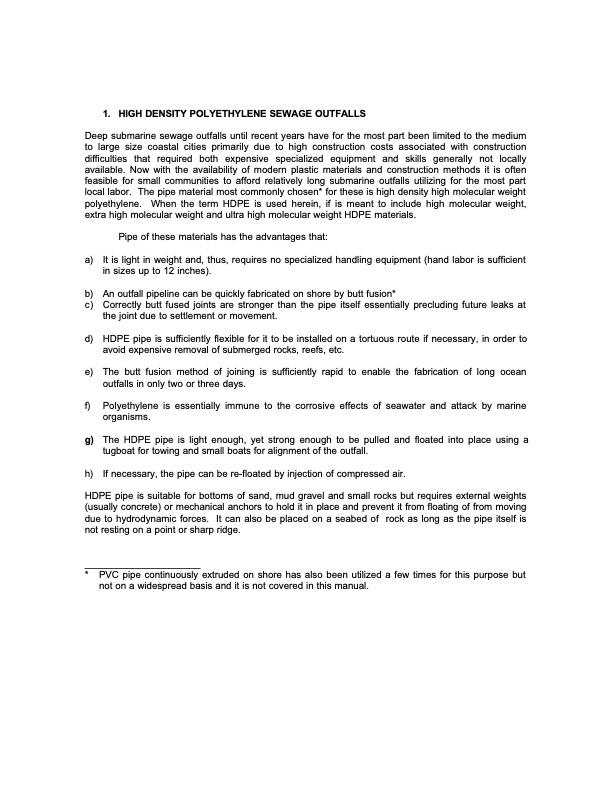
PDF Publication Title:
Text from PDF Page: 003
1. HIGH DENSITY POLYETHYLENE SEWAGE OUTFALLS Deep submarine sewage outfalls until recent years have for the most part been limited to the medium to large size coastal cities primarily due to high construction costs associated with construction difficulties that required both expensive specialized equipment and skills generally not locally available. Now with the availability of modern plastic materials and construction methods it is often feasible for small communities to afford relatively long submarine outfalls utilizing for the most part local labor. The pipe material most commonly chosen* for these is high density high molecular weight polyethylene. When the term HDPE is used herein, if is meant to include high molecular weight, extra high molecular weight and ultra high molecular weight HDPE materials. Pipe of these materials has the advantages that: a) It is light in weight and, thus, requires no specialized handling equipment (hand labor is sufficient in sizes up to 12 inches). b) An outfall pipeline can be quickly fabricated on shore by butt fusion* c) Correctly butt fused joints are stronger than the pipe itself essentially precluding future leaks at the joint due to settlement or movement. d) HDPE pipe is sufficiently flexible for it to be installed on a tortuous route if necessary, in order to avoid expensive removal of submerged rocks, reefs, etc. e) The butt fusion method of joining is sufficiently rapid to enable the fabrication of long ocean outfalls in only two or three days. f) Polyethylene is essentially immune to the corrosive effects of seawater and attack by marine organisms. g) The HDPE pipe is light enough, yet strong enough to be pulled and floated into place using a tugboat for towing and small boats for alignment of the outfall. h) If necessary, the pipe can be re-floated by injection of compressed air. HDPE pipe is suitable for bottoms of sand, mud gravel and small rocks but requires external weights (usually concrete) or mechanical anchors to hold it in place and prevent it from floating of from moving due to hydrodynamic forces. It can also be placed on a seabed of rock as long as the pipe itself is not resting on a point or sharp ridge. ______________________ * PVC pipe continuously extruded on shore has also been utilized a few times for this purpose but not on a widespread basis and it is not covered in this manual.PDF Image | SMALL DIAMETER (HDPE) SUBMARINE OUTFALLS

PDF Search Title:
SMALL DIAMETER (HDPE) SUBMARINE OUTFALLSOriginal File Name Searched:
OPSCEPISPUB0060_eng.PDFDIY PDF Search: Google It | Yahoo | Bing
Development of a solar powered Electric Ship The Electricship website originally started off as a project to develop a comprehensive renewable, affordable, modular electric ship... More Info
Modular Boat Hull Composite The case for a unsinkable, modular composite hybrid boat hull... More Info
MS Burgenstock Hybrid Electric Catamaran Lake Lucerne Unique shuttle servicing Lucerne to the Burgenstock Resort... More Info
Ground Power Unit GPU Powered by Lithium Ion Batteries The goal of the Ground Power Unit is to provide a readily accessible, modular, ready-to-power solution for remote power... More Info
| CONTACT TEL: 608-238-6001 Email: greg@electricship.com | RSS | AMP |